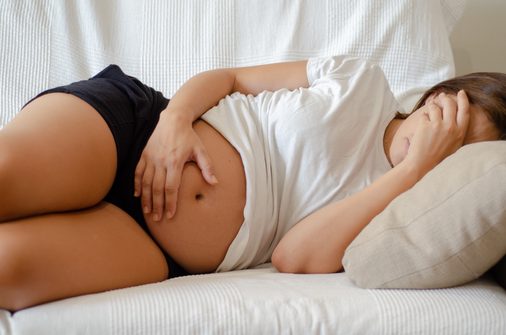
Pelvic girdle pain (PGP) is a condition that affects up to 20% of pregnancies and causes pain, stiffness, and loss of mobility in the pelvic area. PGP can cause pelvic pain or discomfort during any stage of pregnancy and can continue right after delivery. It is often caused by hormonal fluctuations, muscle imbalances, postural changes, and joint stress. The condition is not harmful to a baby utereo, but it can be debilitating for a pregnant mom-to-be.
The pelvic girdle consists of a bowl-shaped ring of bones at the base of your spine. It’s made up of three parts: the sacrum (a triangular bone in your lower back), the coccyx (your tailbone), and your hip bones. Your pelvic girdle is supported by strong ligaments and muscles, including your pelvic floor muscles. Any type of pain in or around your pelvic bones and joints falls under the term pelvic girdle pain (PGP), from a stabbing sensation in the pelvic joint at the front of your pelvis (called the symphysis pubis) to a dull ache in your lower back that can radiate down into your hips and thighs.
Symptoms of Pelvic Girdle Pain
For some individuals, the pelvic joints become stiff and start to move less evenly during pregnancy. This makes the pelvis less stable and can cause inflammation and pain. The added weight of a developing baby changes the way you sit or stand during pregnancy, which can also put extra strain on your pelvis.PGP and its symptoms can vary:
- pain over the pubic bone, roughly level with your hips
- discomfort across one or both sides of your lower back
- a clicking or grinding sensation in the pelvic area
- difficulty walking, going up or down stairs, lifting a leg, or turning over in bed
Treatments for Pelvic Girdle Pain
While pelvic girdle pain can occur while a baby is developing in utero, here are some helpful do’s and don’ts:
- Lean forward and place your hands under your belly bump if you’re going to laugh, sneeze, or cough.
- Avoid laying flat on your back. Try a side position where knees are bent, and pillows are placed between your legs and under your belly.
- Change positions slowly. Do not rapidly or abruptly stand up or get out of bed.
- Do not lift heavy items. Any additional weight can add unwanted stress to the pelvic area.
- Use a knee pillow when you sleep. It supports a growing bump and takes some of the pressure off your pelvic region.
- Stay active. While rest is essential, participating in yoga, swimming, and walking activities can keep your hips from getting stiff, which occurs with inactivity.
- Try not to stand for long periods. Standing for longer intervals can put undue stress on the affected area.
How Chiropractic Care Can Help Moms-To-Be Who Are Experiencing Pelvic Girdle Pain
The hormone relaxin, which is released gradually into your system as pregnancy progresses, can cause instability and unbalanced areas in the body. Keeping your spine and pelvis properly aligned during pregnancy is important to provide the baby optimal room to develop and for mommas-to-be, a balanced body functioning at its best.
Dr. Lydia + Dr. Rachael are both Webster certified, which gives them the knowledge to balance your pelvis and its surrounding tissues during your pregnancy. They can share exercises that help to strengthen the pelvic floor. Schedule a visit for chiropractic care at Vaida, and let us help you proactively keep any pregnancy discomforts at a minimum.
